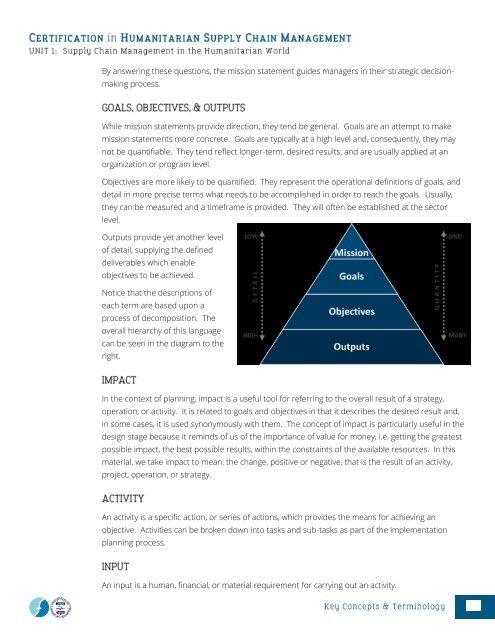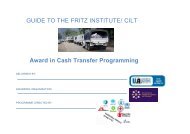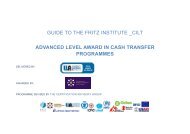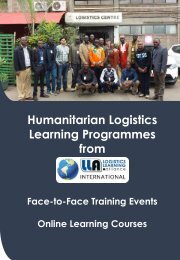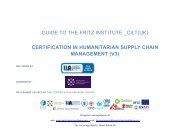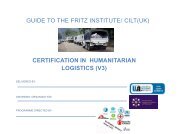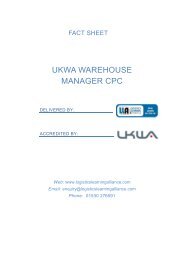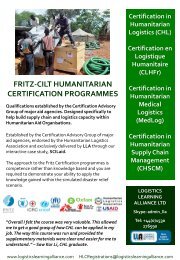CHSCM 3.0 - Unit 1 - SCM in the Humanitarian World
Learning Materials for Unit 1 of the Certification in Humanitarian Supply Chain Management (CHSCM).
Learning Materials for Unit 1 of the Certification in Humanitarian Supply Chain Management (CHSCM).
You also want an ePaper? Increase the reach of your titles
YUMPU automatically turns print PDFs into web optimized ePapers that Google loves.
By answer<strong>in</strong>g <strong>the</strong>se questions, <strong>the</strong> mission statement guides managers <strong>in</strong> <strong>the</strong>ir strategic decisionmak<strong>in</strong>g<br />
process.<br />
While mission statements provide direction, <strong>the</strong>y tend be general. Goals are an attempt to make<br />
mission statements more concrete. Goals are typically at a high level and, consequently, <strong>the</strong>y may<br />
not be quantifiable. They tend reflect longer-term, desired results, and are usually applied at an<br />
organization or program level.<br />
Objectives are more likely to be quantified. They represent <strong>the</strong> operational def<strong>in</strong>itions of goals, and<br />
detail <strong>in</strong> more precise terms what needs to be accomplished <strong>in</strong> order to reach <strong>the</strong> goals. Usually,<br />
<strong>the</strong>y can be measured and a timeframe is provided. They will often be established at <strong>the</strong> sector<br />
level.<br />
Outputs provide yet ano<strong>the</strong>r level<br />
of detail, supply<strong>in</strong>g <strong>the</strong> def<strong>in</strong>ed<br />
deliverables which enable<br />
objectives to be achieved.<br />
Notice that <strong>the</strong> descriptions of<br />
each term are based upon a<br />
process of decomposition. The<br />
overall hierarchy of this language<br />
can be seen <strong>in</strong> <strong>the</strong> diagram to <strong>the</strong><br />
right.<br />
In <strong>the</strong> context of plann<strong>in</strong>g, impact is a useful tool for referr<strong>in</strong>g to <strong>the</strong> overall result of a strategy,<br />
operation, or activity. It is related to goals and objectives <strong>in</strong> that it describes <strong>the</strong> desired result and,<br />
<strong>in</strong> some cases, it is used synonymously with <strong>the</strong>m. The concept of impact is particularly useful <strong>in</strong> <strong>the</strong><br />
design stage because it rem<strong>in</strong>ds of us of <strong>the</strong> importance of value for money, i.e. gett<strong>in</strong>g <strong>the</strong> greatest<br />
possible impact, <strong>the</strong> best possible results, with<strong>in</strong> <strong>the</strong> constra<strong>in</strong>ts of <strong>the</strong> available resources. In this<br />
material, we take impact to mean: <strong>the</strong> change, positive or negative, that is <strong>the</strong> result of an activity,<br />
project, operation, or strategy.<br />
An activity is a specific action, or series of actions, which provides <strong>the</strong> means for achiev<strong>in</strong>g an<br />
objective. Activities can be broken down <strong>in</strong>to tasks and sub-tasks as part of <strong>the</strong> implementation<br />
plann<strong>in</strong>g process.<br />
An <strong>in</strong>put is a human, f<strong>in</strong>ancial, or material requirement for carry<strong>in</strong>g out an activity.


